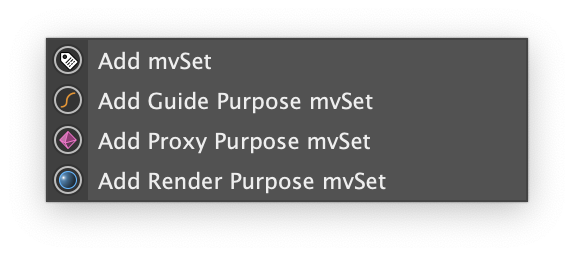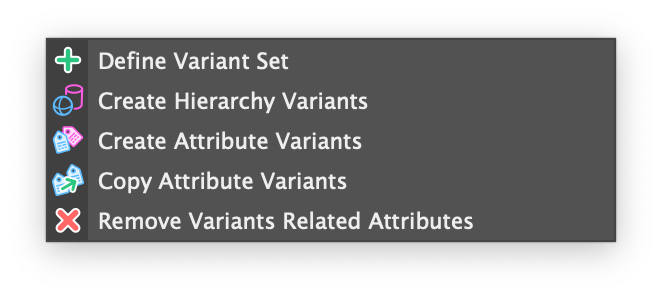# The Multiverse Shelf
Once the MultiverseForMaya plug-in is loaded in Maya, the Multiverse Shelf
will be available.
Most of the Multiverse functionalities are accessible via its shelf (see other UI for more). Please note that you can also automate your workflow via scripting via the easy to use Multiverse Python API.

# Writing
The first three icons on the shelf are writers, they share a red arrow going "outside" of Maya and the red letter "W" as in Write.
For an introduction about Asset, Composition and Override please read the guide.
# Write USD Asset
INPUT → Hierarchy of supported Maya transform and shape nodes
OUTPUT → A single USD asset file (.usd .usdc .usda .usdz)
Write the selected, static or animated, input Maya data to a single output USD file. Typically the input Maya data consists of supported Maya shapes nodes and transform nodes organized in a hierarchy.
Go to the Write USD Asset Documentation.
# Write USD Composition
INPUT → Hierarchy of Multiverse Compound and Maya transform nodes
OUTPUT → A single USD Composition File (.usd .usdc .usda)
Write the selected, static or animated, input hierarchy of of Multiverse
Compounds (mvUsdCompoundShape shape nodes that are created via the Multiverse
Read operation or equivalent API command) and of Maya transform nodes (groups)
as a single USD file.
TIP
Composition writing is also needed when writing Maya instancers nodes (such as those used by MASH instancing) that use Multiverse Compound nodes as the source data for instancing.
Go to the Write USD Composition Documentation.
# Write USD Overrides
INPUT → Selected Multiverse Compound with MEOW overrides
OUTPUT → A single USD Override File (.usd .usdc .usda)
Write static or animated overrides for the selected Multiverse Compound node to a single USD file. Overrides are typically performed in the MEOW UI (Multiverse Explore and Override Window) or with equivalent API commands.
TIP
When writing overrides, an option is available to automatically "sync" the overrides as the topmost layer on their related Compound.
# Write USDZ Material Packages
INPUT → PBR Textures
OUTPUT → A single USDZ material packages (.usdz)
Write a USDZ Material Package. This produce material-only USDZ files: they contain a PBR shading network and include PBR textures, which are specified from the writer UI. These shading networks can be layered on top of USD files and assigned to prims in MEOW.
Note that these networks are encoded with usdPreviewSurface shading networks,
they are portable and usable by many apps and can even preview in Apple Quick
Look and they can also ble rendered with 3Delight NSI.
# Reading
The fourth icon on the shelf is the reader, it has a green arrow going "inside" of Maya and the green letter "R" as in Read.
# Read USD (and other formats)
INPUT → Read USD files (.usd .usdc .usda .usdz)
INPUT → Read ABC files (.abc)
INPUT → Read STEP files (.stp)
INPUT → Read OBJ files (.obj)
INPUT → Read IGES files (.igs)
INPUT → Read STL files (.stl)
OUTPUT → A Multiverse Compound node (mvUsdCompoundShape)
Read a USD file (it is also possible to read other formats as above, which will be converted to USD with an in-memory conversion process).
As a result, a Multiverse Compound node (mvUsdCompoundShape) is created in
Maya: the compound will stream the file data to Maya for manipulation in the
viewport and overrides in MEOW, however no data will never be held in the Maya
scene file.
One of the main characteristics of Compounds is the ability to strategically set the viewport draw mode or USD purpose after of even before reading to avoid loading in the viewport unwanted data or data that may be impossible to draw due to complexity.
The reading UI also provides the functionality to generate and read a "USD clip" from a file-per-frame sequences of USD or ABC files typically coming from Solaris (Houdini). Note that USD files with varying topology generated from either Multiverse (Maya) or Solaris (Houdini) are also supported.
TIP
It is also possible to create a Multiverse compound node without any layer, and that therefore "awaits" to receive data from e.g. a script. Likewise it is possible to point a compound to a "empty" USD file which is then later filled by the pipeline.
# Viewport Draw
# Skip Draw
Skip the viewport draw of the selected Compound. If nothing is selected skip the draw for all compounds.
# Draw Bounding Box
Draw the selected compound as a Bounding Box in the viewport. If nothing is selected draw all compounds as a Bounding Box.
# Draw Bounding Boxes
Draw the selected compound as a hierarchy of Bounding Boxes in the viewport. If nothing is selected draw all compounds as hierarchies of Bounding Boxes.
# Draw Point Cloud
Draw the selected compound as a Point Cloud in the viewport. If nothing is selected draw all compounds as a Point Clouds.
# Draw Smooth
Draw the selected compound with Smooth Shading in the viewport. If nothing is selected draw all compounds with Smooth Shading.
# Draw Preview Materials
Draw the selected compound with smooth shaded USD preview materials (if available in the USD file) in the viewport. If nothing is selected draw all compounds with smooth shaded materials.
# Draw Maya Materials
Draw the selected compound with smooth shading according to the Maya material assigned to the compound at shape level. If nothing is selected draw all compounds with smooth Maya materials.
# Draw Auto Color Materials
Draw the selected compound with a flat set of colors computed automatically. This is slightly faster than drawing a shaded mode.
# Frame USD Prim
Frames the currently selected item (USD prim).
TIP
It is also possible to frame an item via:
- Hotkey: If not already registered,
CTRL+ALT+Fwill be automatically registered on Windows and Linux whileCOMMAND+Fwill be registered on macOS.Note that a different key can be mapped from the Maya Hotkey Editor:
Windows->Settings/Preferences->Hotkey Editor> Custom Script> Multiverse - Marking menu:
RMB > Frame Selected Item
# Create mvSet Node
Create a Multiverse Set node
The Multiverse Set node has multiple functionalities, when clicking its shelf button you will see the following menu:

In order from top-down:
- Setting namespace information for material assignments with attribute overrides in MEOW. ALso it can container renderers-specific set nodes to use as MEOW attribute overrides as well as add custom USD attributes.
- Define the
proxypurpose when writing USD Assets: LMB-click on the icon: second choice. - Define the
renderpurpose when writing USD Assets: LMB-click on the icon: third choice. - Define the
guidepurpose when writing USD Assets: LMB-click on the icon: third choice.
See Generating Viewport Proxies.
When used in the context of attribute sets, is designed to contain renderer
specific set nodes. Inside an mvSet you can put nodes such as:
- Maya
set(typically used by Arnold and VRay) - 3Delight
dlSetnode - Redshift
redshiftAttributeMesh,redshiftVisibilityand other Redshift set nodes. - Vray
vrayObjectPropertiesand other vray set nodes
Note
A Multiverse set node is also created every time an attribute override is set in MEOW, and it can also be used for creating custom USD attributes as overrides.
Heads up!
Don’t put mvUsdCompoundShape nodes inside an mvSet as it is non-sensical:
an mvSet should contain other set-like nodes specific to each renderer as
per listed above, or, Maya geometry when is used for the purpose of writing
proxies.
# Define & Set Variants
Authoring Variants
Multiverse offers a complete workflow to author Variants both on Maya data, and also on USD data encapsulated in Multiverse Compounds. This shelf button relates to the former (Maya data), while MEOW has the UI for the latter (USD data).
Wen clicking the Variant shelf button you will see the following menu:

In order from top-down:
- Define Variant Set. Define a VariantSet on the selected Maya transform node. You will define the name of your variant set and, optionally, the name of the default variant.
- Create Hierarchy Variants. Create your hierarchy variants on the selected Maya transform nodes (if a shape is selected its transform will be used). You will define their name and to which VariantSet they belong to. This is designed for fast multi-authoring of multiple variants.
- Create Attribute Variants. Create your attribute variants on the selected Maya shape nodes. You will define their name and to which VariantSet they belong to. This is designed for fast multi-authoring of multiple variants.
- Copy Attribute Variants. Copy variant attributes from a transform node to another transform node: the last selected is the target in Maya-style.
- Remove Variants Related Attributes: Remove all related variant attributes on the selected Maya nodes.
Note
Since Variants come with their own terminology, we strongly recommend to read well the relative Variant documentation.
# MEOW
Open the Multiverse Explore & Override Windows — (MEOW).
This opens up a high-performance, stackable, persistent and multi-tab panel window called “MEOW”. When a Multiverse Compound is selected, the MEOW will display a hierarchical tree graph where each row represents a node item in the graph (matching exactly how it was written, e.g. by the Multiverse Write Asset or Composition operations or by Solaris or by any other DCC app able to write USD files).
MEOW can hold the hierarchy of more than one Compound by using Tabs. When only the default Tab is used, the elected Compound will be displayed. When a new Tab is created, the selected compound hierarchy will be displayed in such Tab. MEOW will persist upon change in selection with other Maya nodes. When selecting a compound that is not displayed in a Tab, its hierarchy will be displayed in the default Tab.
MEOW can efficiently display extremely complex hierarchies of items. You can use the MEOW to:
- Explore the hierarchy/items of a Multiverse Compound node
- Set Overrides at any point in the hierarchy using the RMB. Note that overrides are inherited by propagation to their children (if not further overridden below in the hierarchy).
- Inspect primitive items using the MMB: this will pop up an info window for the selected item providing info on the data for that location.
You can set and write the following overrides:
- (Mat) material assignment (via shading group
shadingEnginenodes) - (Xfrm) transformations (via locator
transformnodes — with complete and full support for their ancestors and foster parents) - (Attr) attributes (via Multiverse
mvSetnodes) - (Var) variant selection
- (RV) rendering visibility
- Activity state
- Instance-ability state
- (RV) rendering visibility (Maya only, no writing)
Note
Although you can set a Viewport Visibility (VV) override in Maya, this cannot be written as an override in USD as USD only has 1 signle type of visibility (Render Visibility). Multiverse offers the viewport Vs render visibility as it is very useful to lower complexity in the viewport while still allowing for rendering, this idea is similar to Houdini's decoupling of display vs render visibility.
Static or animated overrides can be then either saved in the current Maya scene or written with the Multiverse “Write USD Override” shelf button (see above) and layered on their respective Compound: Multiverse will automatically sync a Compound by creating a new layer for the overrides that were written.
# To usdview
Open the selected Multiverse Compound in usdview, a simple external viewing
application for USD files.
# Read the Docs
Hyperjump to the very same documentation that you are reading 🤓
# Talk on Slack
Hyperjump to our Multiverse Talk Slack Group.
# Info Window
Show information about the version of Multiverse you are using including the license and commit id of the build, for example:
Multiverse for Maya
License: Free or Pro
Version: 8.0.0 - f70bwi7h
USD Version: 22.11
2
3
4
5
# Multiverse Global Settings
Allow to set global Multiverse setting, currently related to the HydraVP2 viewport.

